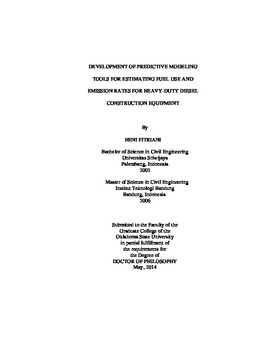| dc.description.abstract | Heavy-duty diesel (HDD) construction equipment consumes a substantial amount of fuels and consequently emits a substantial amount of pollutants into the environment. This dissertation presents methodologies for estimating fuel use and emission rates for HDD construction equipment based on real-world in-use data. Second-by-second data for fuel use and emission rates of nitrogen oxides (NOx), hydrocarbons (HC), carbon monoxide (CO), carbon dioxide (CO2), and particulate matter (PM) along with engine data were collected from 32 items of equipment using Portable Emission Measurement Systems (PEMS). The HDD construction equipment consists of six backhoes, six bulldozers, three excavators, six motor graders, three off-road trucks, three track loaders, and five wheel loaders. Engine performance data that include manifold absolute pressure (MAP), revolutions per minute (RPM), and intake air temperature (IAT) were used to measure the fuel use and emission rates of NOx, HC, CO, CO2, and PM. Predictive fuel use and emission rates models were developed using the weighted average approach, simple linear regression (SLR), multiple linear regression (MLR), and artificial neural network (ANN). Variable correlations and variable impact analysis were also developed for each item of equipment. Based on the summary of Pearson correlation coefficients, MAP had a high positive correlation to fuel use and emission rates of NOx, CO2, and PM, but had a moderate positive relationship with HC and CO. Although not as highly correlated, RPM had a strong positive relationship with fuel use and emissions. IAT was shown to have the lowest correlation of the three engine performance variables on predicting fuel use and emission rates. The weighted average approach is a practical tool to estimate the fuel consumption and emission rates for HDD construction equipment. The method is reliable for real-world use. For SLR, MLR and ANN modeling approaches, CO proved to be the most difficult pollutant emission rate to predict, as evidenced by its low R2 values. Based on the model comparisons, ANN models generally performed the best with respect to precision, accuracy, and bias. In most cases, the ANN approach produced highly precise models for NOx, CO2, and PM; while the models for HC and CO were moderately precise. A potential drawback to the ANN approach is that the equations for each response variable are not actually provided, thus the user must have access to the artificial neural network. Although, the SLR and MLR approaches yielded models that were slightly less accurate and precise than the ANN approach, these models are still useful. | |
